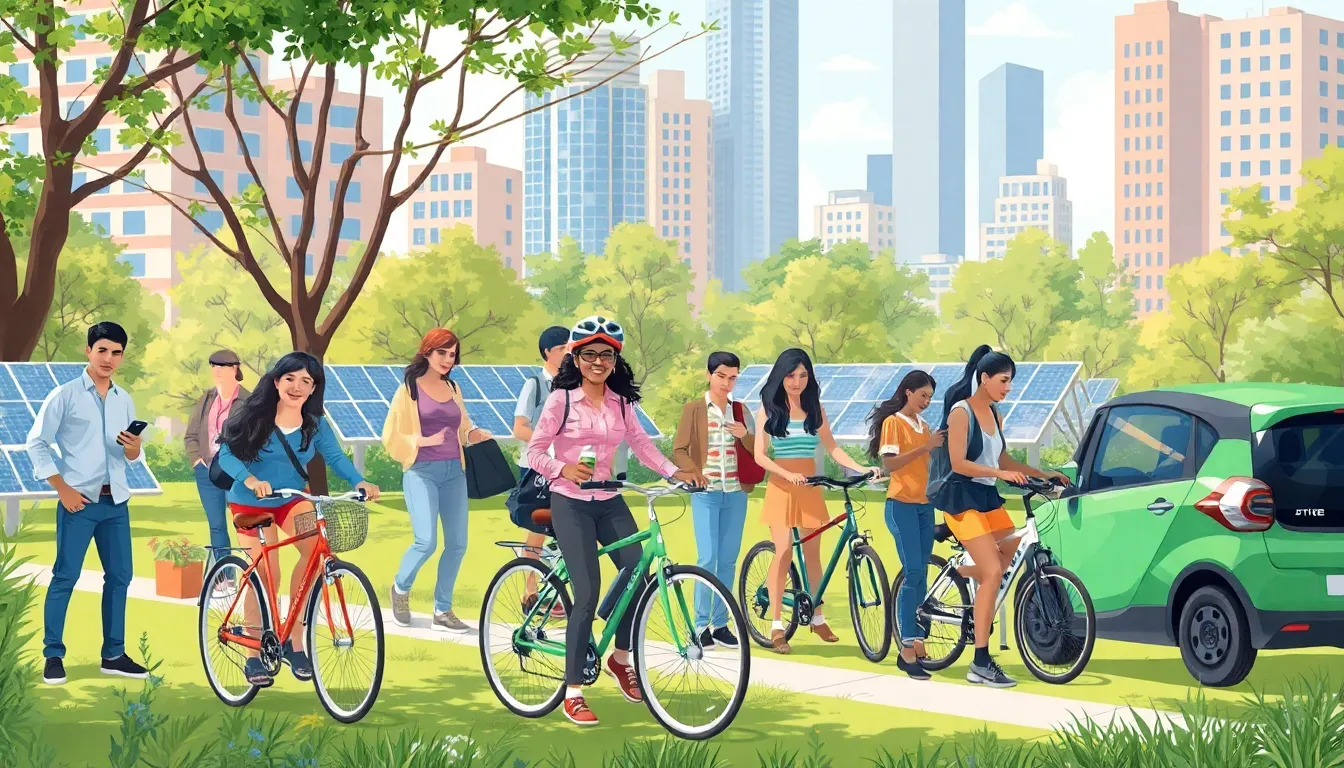Table of Contents
ToggleIn a world where plastic seems to multiply faster than rabbits, making sustainable choices has never been more crucial. It’s time to swap those single-use bags for trendy reusable ones and trade in your gas-guzzler for something a bit greener. After all, saving the planet can be stylish and fun!
Understanding Sustainable Choices
Sustainable choices refer to decisions that maintain environmental balance while meeting current needs. These choices encompass a range of actions and products aimed at reducing damage to ecosystems.
Definition of Sustainable Choices
Sustainable choices involve selecting options that minimize negative impacts on the environment. Choosing reusable bags over single-use plastic is one example. Eating locally sourced produce helps reduce carbon footprints associated with transportation. Furthermore, selecting energy-efficient appliances lowers energy consumption, promoting a healthier planet. Sustainable choices focus on preserving resources for future generations while addressing immediate needs.
Importance of Sustainability
Sustainability plays a crucial role in preserving natural resources for future generations. Eco-friendly practices contribute to cleaner air and water, enhancing overall quality of life. By prioritizing sustainable choices, individuals actively reduce waste and pollution. Communities benefit from improved biodiversity and healthier ecosystems. Moreover, sustainable living can promote economic growth in green industries. Collectively, these steps foster a resilient environment conducive to long-term well-being.
Types of Sustainable Choices

Sustainable choices encompass various options that minimize environmental impact and promote ecological balance. Understanding different types helps individuals make informed decisions.
Eco-Friendly Products
Eco-friendly products aim to limit environmental harm while providing necessary functions. Biodegradable packaging, for instance, breaks down naturally and reduces landfill waste. Reusable straws made from stainless steel or silicone replace plastic versions, which contribute to pollution. Organic materials like cotton and bamboo offer sustainable clothing alternatives to fast fashion. Additionally, cleaning supplies free from harsh chemicals protect both health and ecosystems.
Renewable Energy Sources
Renewable energy sources harness natural processes that replenish themselves. Solar energy, generated from sunlight, powers homes and businesses without carbon emissions. Wind energy utilizes turbines to convert wind flow into electricity, supporting a cleaner grid. Hydropower, sourced from water flow, taps into natural cycles for consistent energy production. These sources collectively decrease reliance on fossil fuels, enhancing energy sustainability.
Sustainable Transportation Options
Sustainable transportation options focus on reducing carbon footprints while improving mobility. Biking promotes health and decreases emissions, making it ideal for short distances. Public transit systems like buses and trains encourage efficient travel for larger populations. Electric vehicles significantly lower greenhouse gas emissions compared to traditional cars. Carpooling also shares rides, reducing the number of vehicles on the road and cutting fuel consumption.
Benefits of Making Sustainable Choices
Making sustainable choices fosters multiple advantages for individuals and communities alike.
Environmental Impact
Sustainable choices significantly reduce waste and pollution. Selecting biodegradable products avoids unnecessary harm to ecosystems. Using renewable energy sources, like solar and wind, decreases reliance on fossil fuels, promoting cleaner air and water. Each individual decision contributes to preserving natural resources and enhancing biodiversity. Communities benefit from improved air quality, which leads to healthier ecosystems. By prioritizing sustainable practices, everyone plays a role in mitigating climate change and protecting the planet for future generations.
Economic Advantages
Economic benefits arise from embracing sustainability. Investing in energy-efficient appliances lowers utility bills and reduces overall consumption. Communities that support local produce stimulate the local economy while minimizing transportation emissions. Additionally, green jobs in renewable energy sectors offer opportunities for growth and innovation. Long-term savings from reduced waste management costs strengthen economic resilience. Fostering sustainable practices creates a thriving marketplace that supports both the planet and the economy.
Health Benefits
Health benefits accompany sustainable living. Choosing locally sourced foods often means consuming fresher, nutrient-rich produce. Reduced pollution levels from sustainable practices lead to fewer respiratory issues and chronic illnesses. Prioritizing eco-friendly products minimizes exposure to harmful chemicals found in many conventional items. Moreover, sustainable transportation options promote physical activity and improve mental well-being. Overall, healthier environments contribute to improved quality of life for individuals and communities.
Challenges to Implementing Sustainable Choices
Implementing sustainable choices presents various challenges that many individuals and communities face. Two significant obstacles include accessibility and affordability, along with awareness and education.
Accessibility and Affordability
Accessing sustainable options often remains difficult for many people. Reusable products like bags and containers may not always be available in every community. Prices for eco-friendly products typically exceed traditional options, discouraging consumers from making sustainable shifts. Assistance from local governments or organizations can help bridge the gap in accessibility and affordability. Creating initiatives that provide financial support for resources enhances the ability of low-income households to adopt sustainable practices. Supporting local businesses that prioritize sustainability may also lead to more affordable and accessible sustainable choices.
Awareness and Education
Awareness regarding the benefits of sustainable choices varies widely among individuals. Many may lack information about the positive impacts that eco-friendly practices have on health and the environment. Efforts to increase education on sustainability can lead to higher engagement in sustainable activities. Schools and community programs can play crucial roles in raising awareness and providing resources. Encouraging discussions about sustainability in social media platforms also helps spread knowledge. As individuals become more informed, they are more likely to adopt environmentally friendly habits. Increasing awareness directly contributes to fostering a culture of sustainability.
Embracing sustainable choices is essential for fostering a healthier planet. By prioritizing eco-friendly practices individuals not only enhance their own lives but also contribute to the well-being of their communities and future generations. Every small decision counts whether it’s opting for reusable bags or supporting local produce.
As awareness grows and accessibility improves more people can engage in sustainable living. This collective effort can lead to significant environmental benefits economic growth and improved health outcomes. Ultimately the journey toward sustainability is a shared responsibility that requires commitment and action from everyone.




